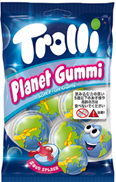ブログ
Changes in media, changes in evidence – recent IP High Court decision recognized the well-known status of a “viral” unregistered trademark -
2024.06.06
Introduction
Proving the well-known status of a mark is quite a challenge in Japan and usually requires a trademark owner to produce a substantial amount of evidence proving extensive use of the mark, typically consisting of advertisements, brochures and magazine articles bearing the trademark. However, in a recent IP High Court (“IPHC”) decision, the IPHC acknowledged the well-known status of an unregistered “nickname” of a certain candy product that was not even used on the product’s packaging based only on a limited amount of evidence and overturned the Trial and Appeal Department of the Japan Patent Office (“JPO”) decision maintaining the registration for a mark identical to such nickname registered by a third party.
“Chikyu Gumi” IP High Court decision
On December 26, 2023, the IPHC issued a decision in an invalidation action against the trademark “Chikyu Gumi” (“earth gummy” in Japanese) registered in connection with “gummy candy” in Class 30 on the basis that such mark was identical to an unregistered well-known trademark for gummy candy in Japan. In the decision, the IPHC recognized that “Chikyu Gumi” was a well-known trademark for gummy candy despite the fact that such mark does not even appear on the product packaging. (2023 (Gyo-ke) 10079)

|
The plaintiff’s product “Planet Gummi.” Yutaka Trading Company Limited. |
These products went viral among younger-generation consumers who are frequent users of social media because of the earth shape of the products, through such consumers calling them “Chikyu Gumi,” a term which a retailer named when it advertised such products. As such, the evidence submitted by the plaintiff did not include any marketing materials such as advertisements, brochures, etc. prepared and distributed by the plaintiff as would usually be submitted when trying to prove the well-known status of a mark, except for only a few Instagram posts with the hashtag “#Chikyu Gumi,” etc. Rather, it was mostly posts on social media platforms (Twitter/X and Instagram, etc.), posted by third parties, as well as a few newspaper/magazine articles, online news articles, and television coverage introducing the craze for the candy. There were only around 40 pieces of evidence submitted, which is very limited compared to other cases, and the plaintiff did not even present details on sales figures or market share, which are viewed as some of the most important evidence in showing the penetration of products (and marks) in the market when proving the well-known status thereof. The IPHC nevertheless ruled that the “Chikyu Gumi” mark was well-known in Japan, finding as follows:
“The plaintiff's products are confectionery manufactured by a foreign company and are called "Trolli Planet Gumi" or "Planet Gumi", and neither the plaintiff's products, their packaging nor their individual packaging contain the Japanese characters “Chikyu Gumi”. However, the plaintiff's products became very popular in Korea around 2018, mainly among video posters and their viewers, and this trend spread to Japan, and they achieved high popularity in Japan around 2020, mainly among video posters and their viewers, and by October of the same year, when the plaintiff began importing and selling the products, a retailer with stores nationwide began to advertise the products as “Chikyu Gumi.” They were sold out immediately after being released for sale at retailers’ stores, making them extremely difficult to purchase. Since the time the plaintiff began importing and selling the products, retailers with stores nationwide have repeatedly advertised the products as “Chikyu Gumi,” and the products have also become extremely popular on video sharing sites, where they were again called “Chikyu Gumi.” In June 2021, the plaintiff’s products were reported in national newspapers and on television by a major station in Osaka as very popular products called “Chikyu Gumi,” and in the television coverage, the products were highly ranked among the rankings of foods and beverages that were popular with Generation Z in the first half of the same year. The plaintiff's products were also reported on television by a major station in Tokyo in July 2021 as popular products and were introduced as something that all young people in their early twenties knew about (Note that the plaintiff started calling them “Chikyu Gumi” on television programs at the latest in June 2021 and began advertising them as “Chikyu Gumi” at the latest in September 2021). Furthermore, in November 2021, the plaintiff's products were introduced alongside novels and songs as examples of works or products that became popular after being posted on video sharing sites, and also won second place in the “Café/Gourmet” category of the “SHIBUYA109lab. Trend Target 2021” awards, which were the results of a survey (targeting 545 females aged 15 to 24) conducted by the management company of a well-known department store in Shibuya. Based on the trends of the product up to 2021, the “Basic Knowledge of Modern Terms 2022,” published in January 2022 featured the term “Chikyu Gumi,” which is the nickname for the products, as a product that attracted attention in 2021.
Given the above circumstances, it is reasonable to find that the words “Chikyu Gumi” formed a trademark that was widely recognized among consumers (who are deemed to be consumers of gummy candy, particularly young people, in light of the content and nature of the products for which the plaintiff’s mark is used and the facts stated in the above) as indicating the products related to the business of the plaintiff or the manufacturer of the plaintiff's products by the date on which the Decision of Registration of the owner’s trademark was issued, February 22, 2022, at the latest.”
Conclusion
It is generally a high hurdle to establish well-known status of a trademark in Japan as the owner of the mark must prove its continuous use of the mark (usually for at least around 10 years) by submitting a substantial amount of marketing materials, including advertisements; namely, the amount of evidence presented is regarded as the most important decisive factor in determining the well-known status of a mark in Japan. In this case, however, “Chikyu Gumi” was recognized as a well-known trademark with very limited evidence, most of which was not even evidence of use by the owner itself but by third parties on social media within just a few years. This IPHC decision demonstrates the significant influence of a new type of evidence, social media, as well as the impact of “going viral” on social media. What makes this case worthy of reference is the fact that: (i) the mark was not the name of the products but just a nickname given by a third party and was therefore not used on the product; (ii) the evidence mostly showed use of the mark by third parties, not by the owner itself; and (iii) the mark was mainly used verbally on TV or as a hashtag. Just like in broader society, traditional media is being replaced by new media in the field of law, and with the all-encompassing spread of social media, the speed at which things become common knowledge has dramatically increased. With the advent of social media, the evidence of use by third parties could become sufficiently adequate and the hurdle for trademark owners to prove the well-known status of a mark in Japan may be lowered.
Member
PROFILE

